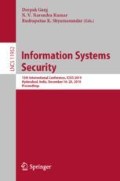Abstract
This note is a brief introduction to CellTree, a new architecture for distributed data repositories, drawing liberally from our article which introduces the concept in greater detail [15].
A CellTree allows data to be stored in largely independent, and highly programmable cells, which are “assimilated” into a tree structure. The data in the cells are allowed to change over time, subject to each cell’s own policies; a cell’s policies also govern how the policies themselves can evolve. A design goal of the architecture is to let a CellTree evolve organically over time, and adapt itself to multiple applications. Different parts of the tree may be maintained by different sets of parties and the core mechanisms used for maintaining the tree can also vary across the tree and over time.
We outline the architecture of a CellTree, along with provable guarantees of liveness, correctness and consistency that can be achieved in a typical instantiation of the architecture. These properties can be guaranteed for individual cells that satisfy requisite trust assumptions, even if these assumptions don’t hold for other cells in the tree. We also discuss several features of a CellTree that can be exploited by applications. Finally, we briefly outline a sample application that can be built upon the CellTree, leveraging its many features.
Access this chapter
Tax calculation will be finalised at checkout
Purchases are for personal use only
Notes
- 1.
For meaningful guarantees, when a policy rewrites itself, the newly resulting policy needs to validate that the old policy is acceptable to it as a policy to evolve from.
- 2.
Even architectures like IOTA’s Tangle [14], that do not stick to a chain structure use hash pointers in the same direction as blockchains.
- 3.
Note that the same version of a cell may be part of multiple such Merkle trees, if for instance, an ancestor of that cell evolves through multiple versions before the cell itself evolves. This in fact, gives rise to a Merkle Multi-Tree, which is a collection of Merkle trees in which any two may share some subtrees.
References
Enabling blockchain innovations with pegged sidechains (2014). https://blockstream.com/sidechains.pdf
Cardano (2015). https://www.cardano.org
The bitcoin lightning network: scalable off-chain instant payments (2016). https://lightning.network/lightning-network-paper.pdf
Leemon, B., Mance, H., Paul, M.: Hedera: a governing council and public hashgraph network (2017). https://www.hederahashgraph.com/whitepaper
Benet, J.: IPFS - content addressed, versioned, P2P file system. CoRR, abs/1407.3561 (2014)
Cullen, A., Ferraro, P., King, C.K., Shorten, R.: Distributed ledger technology for IoT: parasite chain attacks. CoRR, abs/1904.00996 (2019)
Gilad, Y., Hemo, R., Micali, S., Vlachos, G., Zeldovich, N.: Algorand: scaling byzantine agreements for cryptocurrencies. In: Proceedings of the 26th Symposium on Operating Systems Principles, pp. 51–68. ACM (2017)
Haber, S., Stornetta, W.S.: How to time-stamp a digital document. In: Menezes, A.J., Vanstone, S.A. (eds.) CRYPTO 1990. LNCS, vol. 537, pp. 437–455. Springer, Heidelberg (1991). https://doi.org/10.1007/3-540-38424-3_32
Kiayias, A., Russell, A., David, B., Oliynykov, R.: Ouroboros: a provably secure proof-of-stake blockchain protocol. In: Katz, J., Shacham, H. (eds.) CRYPTO 2017. LNCS, vol. 10401, pp. 357–388. Springer, Cham (2017). https://doi.org/10.1007/978-3-319-63688-7_12
Kilian, J.: A note on efficient zero-knowledge proofs and arguments. In: Proceedings of the Twenty-Fourth Annual ACM Symposium on Theory of Computing, pp. 723–732. ACM (1992)
Merkle, R.C.: Method of providing digital signatures. US Patent 4309569 (1982)
Merkle, R.C.: A digital signature based on a conventional encryption function. In: Pomerance, C. (ed.) CRYPTO 1987. LNCS, vol. 293, pp. 369–378. Springer, Heidelberg (1988). https://doi.org/10.1007/3-540-48184-2_32
Nakamoto, S.: Bitcoin: a peer-to-peer electronic cash system (2009). http://www.bitcoin.org/bitcoin.pdf
Popov, S.: The tangle (2017). http://iotatoken.com/IOTA_Whitepaper.pdf
Prabhakaran, M., Trehan, A., Acharya, A.: CellTree: a new paradigm for distributed data repositories (2019). https://eprint.iacr.org/2019/516
Author information
Authors and Affiliations
Corresponding authors
Editor information
Editors and Affiliations
Rights and permissions
Copyright information
© 2019 Springer Nature Switzerland AG
About this paper
Cite this paper
Acharya, A., Prabhakaran, M., Trehan, A. (2019). An Introduction to the CellTree Paradigm (Invited Paper). In: Garg, D., Kumar, N., Shyamasundar, R. (eds) Information Systems Security. ICISS 2019. Lecture Notes in Computer Science(), vol 11952. Springer, Cham. https://doi.org/10.1007/978-3-030-36945-3_8
Download citation
DOI: https://doi.org/10.1007/978-3-030-36945-3_8
Published:
Publisher Name: Springer, Cham
Print ISBN: 978-3-030-36944-6
Online ISBN: 978-3-030-36945-3
eBook Packages: Computer ScienceComputer Science (R0)

